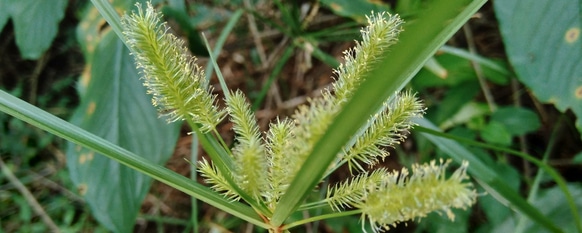Nutsedge, (Cyperus rotundus) is a perennial plant that is akin to a double-edged blade.
For hunter-gatherers in tropical regions, it is a staple carbohydrate. In some agrarian cultures, it is used as food during periods of famine.
The nutsedge is commonly used in both Traditional Chinese Medicine and Indian Ayurvedic Medicine. In both disciplines, the nutsedge is used to treat dysmenorrhea, fever, and gastrointestinal issues.
Portions of the plant contain antibacterial properties. These parts are used to treat wounds, burns, and even tooth decay. More than 20 different chemical compounds with modern applications have been derived from nutsedges.
Have you ever heard of lawn sand? Learn when and how to use lawn sand in our article here on the Green Pinky.
However, it also has its not so desired qualities.
Nutsedge (also known as Java grass, coco-grass, nutgrass, and both purple and yellow nutsedge) is one of the most invasive weeds in the entire plant kingdom. As it has spread to the four corners of the planet, it developed a name for itself as “the world’s worst weed.” In the United States, the nutsedge can be found in all of the lower 48.
If you want to learn more about this weed, you’ll want to read this guide closely. In this article, you’ll learn how to identify this invasive and vigorous plant. We’ll discuss where it gets all of that vigor from as well. And we’ll wrap it all up by giving you the information you’ll need to prevent it and, if prevention fails, how to get rid of it.
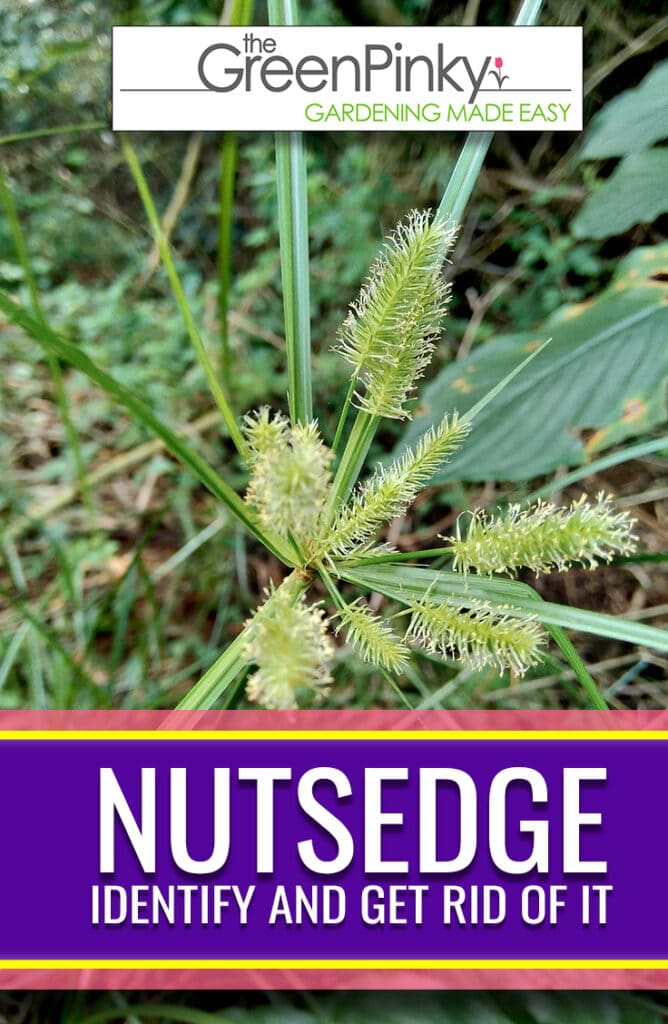
How To Identify
First and foremost, I need to clear some things up about nutsedge. Although nut grass most certainly resembles grass, it is a grass in name only.
It is a species of sedge in the Cyperaceae family. Cyperaceae is a family of around 90 different genera and more than 5000 species.
Some species of nutsedge are capable of growing more than 12 feet tall if left unchecked.
The “nut” portion of its name is derived from its tubers. If you didn’t know better, it would be easy to mistake them for nuts due to their resemblance.
Young Nutsedge
Immature nutsedge first forms fleshy white rhizomes singularly or in chains depending on the species. These rhizomes grow to be up to an inch in diameter.
What’s odd about these rhizomes is that they grow in two different directions. Most of you are familiar with the rhizomes that creep out horizontally from the base of the plant hugging the ground. Nutsedge has these horizontal rhizomes that are reddish-brown in color.
Nutsedge also has rhizomes that grow vertically up from the soil. Once the vertical rhizomes grow upward, they form a bulbous structure. From that bulbous structure grows both fresh shoots and new roots. New rhizomes are formed and grow out from newly formed roots.
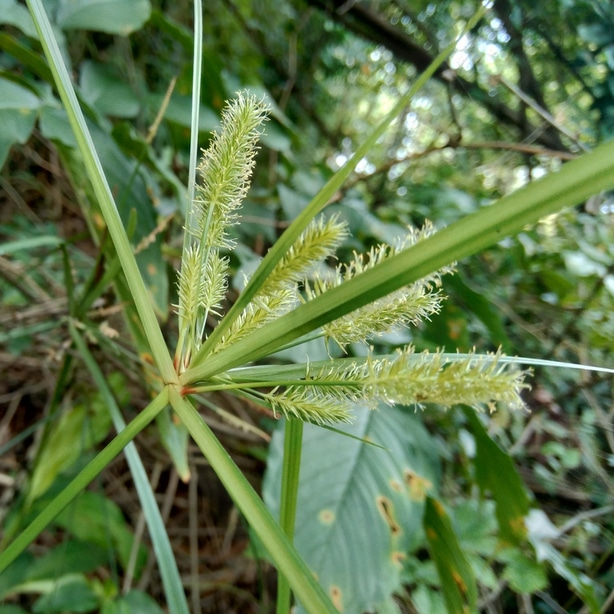
Mature Nutsedge
Let’s break the plant down into its individual parts to aid in identification.
Stems
The primary feature that distinguishes the nutsedge is its stems. Remember this little limerick: “Sedges have edges.” That is, nutgrass has distinctly triangular stems and, as such, has 3 sides and edges.
Take a cross-section of the stem and this shape is easily seen. You can also roll it around in your fingers and know immediately what you’re holding.
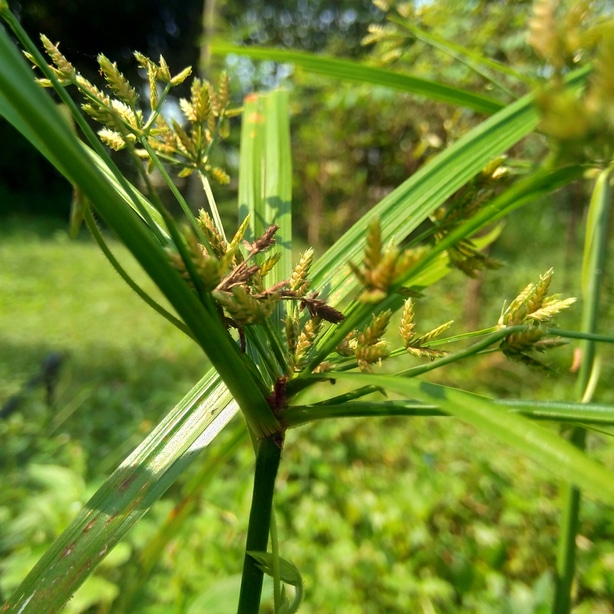
Leaves
The leaves of the nutsedge grow in rows of 3 from the plant’s base. The leaves appear waxy and sort of glisten in the sunlight. The nutgrass’ leaves are hairless and smooth to the touch as well.
The leaves of the different species of nutsedge taper towards the end, but they do differ in how that end terminates. The leaves have a pronounced middle rib and grow into a “V” shape. They can be anywhere from 2 to 10 inches long.
Flowers
The flowers of nutsedges are arranged on 3 to 8 uneven spikelets. The flowers grow in clusters on the spikelets. The color and number of the flowers on these spikelets differ based upon the species of nutsedge you have.
The flowers are equipped with female pistils that have three stigmas. They have three male stamina as well. This makes the nutsedge a bisexual plant.
Fruit
The small achenes carry a single seed within them. Some species do not go to seed at all. The fruit is oblong like a football. Like the stems, it also has a triangular cross-section.
The two most common nutsedge plants are yellow and purple nutsedge. Let’s take a look at what sets them apart from one another.
Yellow Nutsedge (Cyperus esculentus)
You might have already guessed that yellow nutsedge is, well, yellow somewhere on its structure. You’re correct. The seed head and flowers are a deep golden yellow that borders on dijon in color. This species has yellowish-green leaves as well. They also have a long tip that comes to a fine, rigid point.
On the tips of the yellow nutsedge’s rhizomes grow single tubers instead of chains.
The yellow nutsedge will pop up on your lawn or in your garden earlier than its purple counterpart. When this species matures, it reaches a height between 12 and 18 inches.
Yellow nutsedge is also more tolerant of colder temperatures than its purple nutsedge. This is why the yellow cultivar being more widespread.
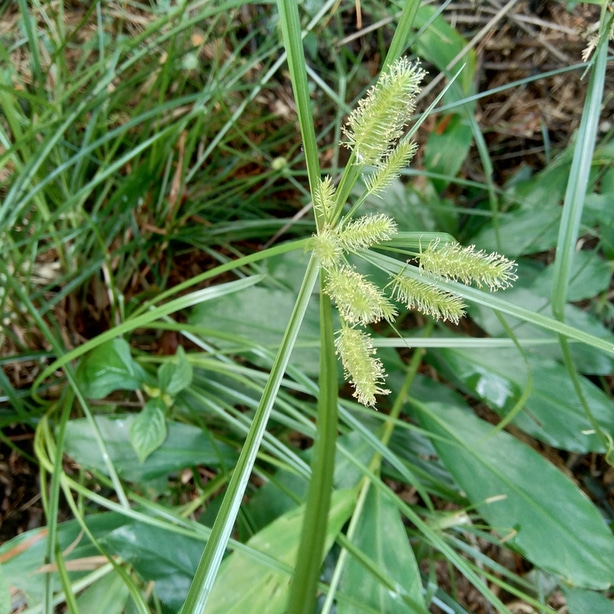
Purple Nutsedge (Cyperus rotundus)
The flowers and seed heads of the purple nutsedge are, brace yourself for it, purple.
The purple nutsedge leaves also taper towards the end, but they terminate abruptly and form a blunt point. They are also a markedly darker green than the light green leaves of their yellow brethren.
On the purple nutsedge’s rhizomes, single tubers grow together and connect to form strong chains.
The purple cultivar will appear later in the growing season than its yellow comrade. Its mature height is much smaller as well. It grows to be 6 inches tall at most and usually winds up being shorter than that.
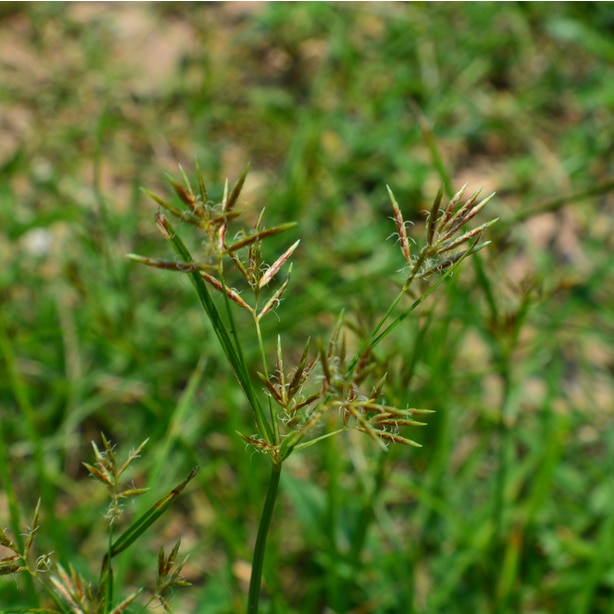
Why Is It So Hard to Get Rid Of?
Nutsedge wasn’t deemed “the world’s worst weed” because it’s quick to give up the space they took over in your lawn or garden.
And it all comes down to the tubers growing from the rhizomes beneath the soil’s surface. Even though they only grow 1 foot deep in the soil outward from the base. They also have a virile tap root to contend with as well.
As the rhizomes grow these chains of interwoven tubers, the nutsedge secures itself into the ground like an anchor. Those tubers can remain viable in the soil for up to 10 years on top of that.
Combine these vigorous tubers, the plant’s seed production, and the nutsedge will sprout, grow, and establish itself from late spring to late summer.
Perhaps I’m underselling just how profound the growth of these tubers is. Let me enlighten you. In a single year, one tuber can produce nearly 2000 new shoots and nearly 7000 new tubers. One year. One tuber.
Imagine your coco-grass problem started with a plant that had ten tubers. In a year, those ten tubers will have turned into 20,000 fresh shoots and 70,000 new tubers.
Not to mention that if you try to pull nutsedge from the soil and leave even a small piece of rhizome or tuber, it will regenerate.
Getting Rid of It
Let’s look at how to prevent this invasive and quick-fire growing perennial plant from showing up and how to go about it if it’s already crashed the garden party.
Prevention
This weed thrives in environments with a surplus of moisture. So, you must make sure that your soil is draining efficiently. Don’t over-water and double-check your irrigation system for any leaks or other issues that could saturate the ground.
Another unnerving thing about these weeds is that while they establish themselves well in very moist soil, once they are established, they grow equally well in normal moisture conditions along with drought as well.
Ensure that your lawnmower is set at the optimal mowing height for the type of grass growing on your lawn. Scalping or mowing too short will wind up stimulating the growth of the nutsedge.
If you’re laying sod in any capacity, check the soil on each slab. Although tubers and rhizomes grow prolifically, they are actually quite brittle. Individual specimens tend to break and remain in the soil. And, if they break and remain, a new weed will begin growing a new root system and making a comeback.
Use a pre-emergent herbicide in the spring and fall to prevent nutsedge on your lawn or in your garden.
As always, the best way to prevent Java grass and any other unwanted vegetative invader is through proper lawn care and maintenance practices. Grow a thick and healthy lawn with soil that drains well, and you will dramatically reduce these weeds’ opportunities to take over.

Removal
Prevention is ideal. Once these chains of shoots and tubers get to growing, it is a nightmare to try to play cath-up.
However, if this invasive plant has already established itself in your lawn, you will need to proactively get rid of it.
You can control these weeds with post-emergent herbicides. Here are a few that I recommend:
- Sedgehammer (halosulfuron-methyl)
- Lontrel (clopyralid)
- Dismiss (sulfentrazone)
- Manor (metsulfuron)
- Basagran T/O (bentazon)
Sedgehammer is by far my go-to post-emergent herbicide when it comes to combatting these plants. It is selective and won’t harm any of your desirable grasses, trees, or ornamentals. It is also effective at killing the highest number of different species.
If you’d like to keep it organic, you can use vinegar with an acetic acid concentration of 15% to 20%. Put the vinegar directly into the spray bottle without diluting it and spray it on the weeds. Take care not to spray anything you don’t want to die. Remember, vinegar is non-selective.
Apply your post-emergent herbicides while the soil moisture is adequate and the weeds are actively growing. This ensures the efficient absorption of the weed killer.
Applying post-emergents during hot and dry conditions will negatively impact your control efforts. This weed is difficult to control as it is, you don’t want to help it out.
Avoid mowing for several days before spraying. This ensures that the weed killer will come in contact with the maximum surface area of the plant. Allow two days to pass before you mow your lawn. This gives the post-emergent chemicals time to soak into the weeds and work their magic.
You already know that any of those brittle rhizomes or tubers left in the soil will regenerate into new problem plants. For that reason, it’s not recommended that you try to pull these weeds by hand.
You can try to pull them when they are young if you’re confident you’ve caught them early enough. You’ll have a better chance at getting all of those regenerating parts of the weed out of the soil. But just because it’s young is certainly no guarantee.
If you insist on removing these weeds mechanically, you must dig at least 1 foot deep and at least 1 foot beyond the circumference of the spread of the weed’s leaves. This should be done in early spring before the tubers have had the opportunity to begin their exponential growth.
This may take you several attempts as any mature tuber can regenerate up to a dozen times before it finally dies off. So, mechanical control should be considered a long-term project. Because it will definitely require you to put many hours into it.

